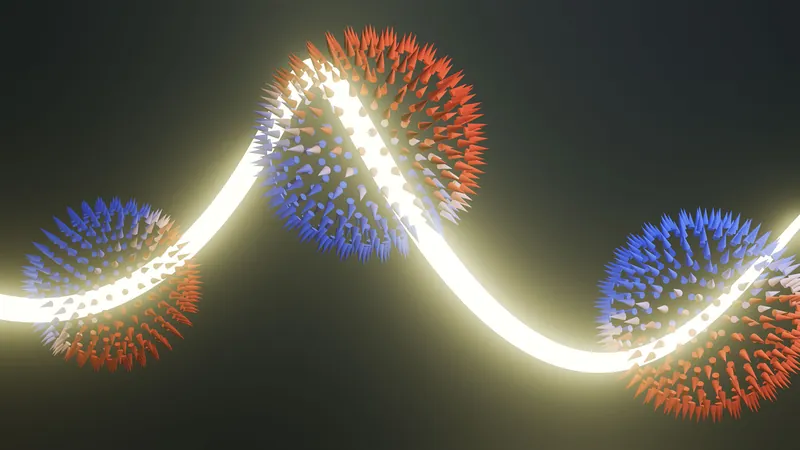
Breakthrough in Orbitronics: Scientists Discover Orbital Angular Momentum Monopoles for Energy-Efficient Technology
2024-09-27
Breakthrough in Orbitronics
In an exciting development for energy-efficient technologies, researchers have successfully demonstrated the existence of orbital angular momentum (OAM) monopoles, which could revolutionize the field of orbitronics—a new alternative to traditional electronics focused on reducing environmental impact. This groundbreaking discovery, made possible through advanced experiments conducted at the Swiss Light Source (SLS) at the Paul Scherrer Institute (PSI), has been detailed in a recent publication in *Nature Physics*.
While conventional electronics rely on the charge of electrons to transfer information, orbitronics shifts the paradigm by utilizing other intrinsic properties of electrons. Until recently, spintronics, which leverages the spin of electrons, held the spotlight. Now, with the advent of orbitronics, researchers are investigating the potential of the orbital angular momentum of electrons. This emerging field promises to enhance memory devices and energy efficiency by potentially generating significant magnetization with minimal electric charge.
The challenge lies in identifying suitable materials capable of supporting OAM flows, which are essential for practical orbitronics applications. Researchers led by scientists from PSI and the Max Planck Institutes in Germany have turned their attention to chiral topological semi-metals—a unique class of materials recognized for their capacity to generate currents of OAMs.
Chiral Topological Semi-Metals: A Game-Changer for Orbitronics
Once overlooked in favor of conventional materials, chiral topological semi-metals have emerged as promising candidates since their discovery five years ago. Characterized by a helical atomic structure, akin to that of DNA, these materials inherently produce OAM textures without the necessity for external stimuli. According to Michael Schüeler, a prominent physicist involved in the study, this intrinsic property enables the creation of stable and efficient OAM currents under ordinary conditions.
The Allure and Complexity of OAM Monopoles
Among the various OAM textures theorized in chiral topological semi-metals, OAM monopoles are particularly intriguing. These monopoles radiate OAM uniformly from a single point, reminiscent of a hedgehog's spikes. Their isotropic nature means that OAM flows can be generated in any direction, making them incredibly valuable for future applications.
Despite their theoretical promise, OAM monopoles have been a challenging concept to translate into experimental evidence. Researchers have relied on Circular Dichroism in Angle-Resolved Photoemission Spectroscopy (CD-ARPES) to study these phenomena. However, interpreting data has proved difficult due to complexities inherent in the experimental techniques.
Bridging Theory and Experiment
In their recent research, Schüeler and his team tackled these challenges by comprehensively analyzing two types of chiral topological semi-metals—specifically, those composed of palladium-gallium and platinum-gallium. Through rigorous theoretical frameworks and careful manipulation of photon energies, they were able to clarify the dynamics of OAM signals that had previously appeared chaotic. This critical step led to a breakthrough by confirming the presence of OAM monopoles.
New Exploration Avenues in Orbitronics
With this progress, researchers can now accurately visualize and manipulate OAM monopoles, revealing a fascinating property: the directionality of OAM spikes can be controlled based on the chirality of the crystal used. This capability opens up a world of possibilities for designing versatile orbitronics devices tailored to specific applications.
The implications of this discovery extend beyond just orbitronics. The ability to engineer and exploit OAM textures in various materials could pave the way for advancements in quantum computing, communication technologies, and other areas where energy efficiency is crucial. As scientists continue to explore this uncharted territory, we stand on the brink of a technological revolution that harnesses the nuances of electron behavior, promising a greener and more efficient future.


 Brasil (PT)
Brasil (PT)
 Canada (EN)
Canada (EN)
 Chile (ES)
Chile (ES)
 España (ES)
España (ES)
 France (FR)
France (FR)
 Hong Kong (EN)
Hong Kong (EN)
 Italia (IT)
Italia (IT)
 日本 (JA)
日本 (JA)
 Magyarország (HU)
Magyarország (HU)
 Norge (NO)
Norge (NO)
 Polska (PL)
Polska (PL)
 Schweiz (DE)
Schweiz (DE)
 Singapore (EN)
Singapore (EN)
 Sverige (SV)
Sverige (SV)
 Suomi (FI)
Suomi (FI)
 Türkiye (TR)
Türkiye (TR)